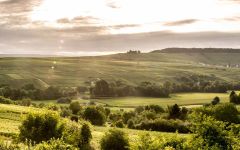Dehours Terre de Meunier Extra Brut
-
Wilfred
Wong



Product Details
Your Rating
Somm Note
Winemaker Notes
Professional Ratings
-
Wilfred Wong of Wine.com
COMMENTARY: The Champagne Dehours & Fils Terre de Meunier is striking and precise. TASTING NOTES: This wine excels with aromas and flavors of mineral notes and chalkiness. Pair it with grilled oysters and a side salad of fresh garden lettuce. (Tasted: November 4, 2022, San Francisco, CA)



The Dehours estate was founded by winemaker Jérôme Dehours' grandfather, Ludovic, in 1930 and was among the first independent growers. Jérôme’s father, Robert, then took over the reins, but unfortunately he passed away when Jérôme was young, and a group of financial partners took control of the business. In 1996, Dehours was able to take the estate back into family hands with a focus on sustainable viticulture and an increasing emphasis on the character of individual terroirs. Today, Jerome uses his excellent wines to demonstrate the outstanding potential of Pinot Meunier, which he holds up as the identity of the Marne Valley and of his estate.
In the words of Peter Liem, “Dehours is increasingly becoming better known among champagne aficionados as a source of mouth-filling, boldly-flavored and terroir-expressive wines.”

A term typically reserved for Champagne and Sparkling Wines, non-vintage or simply “NV” on a label indicates a blend of finished wines from different vintages (years of harvest). To make non-vintage Champagne, typically the current year’s harvest (in other words, the current vintage) forms the base of the blend. Finished wines from previous years, called “vins de reserve” are blended in at approximately 10-50% of the total volume in order to achieve the flavor, complexity, body and acidity for the desired house style. A tiny proportion of Champagnes are made from a single vintage.
There are also some very large production still wines that may not claim one particular vintage. This would be at the discretion of the winemaker’s goals for character of the final wine.

Associated with luxury, celebration, and romance, the region, Champagne, is home to the world’s most prized sparkling wine. In order to bear the label, ‘Champagne’, a sparkling wine must originate from this northeastern region of France—called Champagne—and adhere to strict quality standards. Made up of the three towns Reims, Épernay, and Aÿ, it was here that the traditional method of sparkling wine production was both invented and perfected, birthing a winemaking technique as well as a flavor profile that is now emulated worldwide.
Well-drained, limestone and chalky soil defines much of the region, which lend a mineral component to its wines. Champagne’s cold, continental climate promotes ample acidity in its grapes but weather differences from year to year can create significant variation between vintages. While vintage Champagnes are produced in exceptional years, non-vintage cuvées are produced annually from a blend of several years in order to produce Champagnes that maintain a consistent house style.
With nearly negligible exceptions, . These can be blended together or bottled as individual varietal Champagnes, depending on the final style of wine desired. Chardonnay, the only white variety, contributes freshness, elegance, lively acidity and notes of citrus, orchard fruit and white flowers. Pinot Noir and its relative Pinot Meunier, provide the backbone to many blends, adding structure, body and supple red fruit flavors. Wines with a large proportion of Pinot Meunier will be ready to drink earlier, while Pinot Noir contributes to longevity. Whether it is white or rosé, most Champagne is made from a blend of red and white grapes—and uniquely, rosé is often produce by blending together red and white wine. A Champagne made exclusively from Chardonnay will be labeled as ‘blanc de blancs,’ while ones comprised of only red grapes are called ‘blanc de noirs.’
